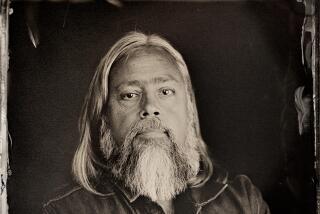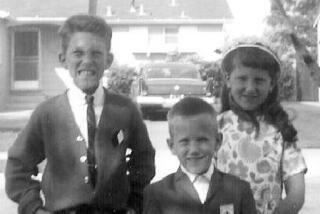Return to Childhood Home Helps Adults ‘Untangle Any Knots in Ourselves’
A year and a half ago, Gloria Smith returned to her hometown of Rincon, Puerto Rico, to re-establish ties with her relatives. When she stepped into her childhood home she began to laugh. Then she began to cry.
“Returning brought a lot of good memories,” said the 57-year-old resident of Rancho Palos Verdes, “and a lot of bad ones too.”
Half of the wood frame house had been swept away in a hurricane but parts of it were recognizable. “I used to see the ocean from my kitchen window,” Smith recalled, “so when I went where I thought the kitchen was I looked out at the ocean again.”
Standing with tears in her eyes in the deserted shell of the place she once called home, she remembered how her parents got sick there and died. But then she was cheered up by memories of climbing a nearby mango tree that still stands today and how at Christmastime her father brought home grapes and walnuts, a special treat.
“When I stepped in the house I started crying,” Smith said, “because I remembered about things when I was little.”
Kathleen Shannon understands.
“If we want to untangle any knots in ourselves, we have to go back to where they got tied,” said the Vancouver filmmaker who has produced several documentaries about homecoming. “The things that happen to us during our early years color the rest of our lives until we go back and understand them.”
Barbara De Angelis, who conducts personal growth seminars in Los Angeles, agreed:
“Going back to our childhood is an important part of our development and our becoming an adult and leaving behind a lot of the baggage we bring from childhood.”
We receive 80% of our emotional programming in the first eight years of life, she said. So our childhood home becomes very important. Visiting it is like “years of therapy.”
“If I were running the ultimate seminar on life, I would take each person to their childhood home and have them say what they needed to say,” she added.
Instead, De Angelis encourages people to return in their imagination. Look at it, smell it, feel its ambience, she said. “That helps people to access a lot of emotions they had as a child that are affecting their relationships today,” she said.
A number of years ago David Lionel, a Los Angeles video producer, made that pilgrimage to relive the experiences of his childhood home.
“I wanted to get in touch with my feelings,” said Lionel, who went back to the “solid, slightly elegant” building in Chicago where he grew up. He did not knock on the door of the apartment for fear of disturbing its occupants.
Instead he stood on the busy corner, tears welling up as scenes flashed before his eyes: roller skating, playing hopscotch, daydreaming in the leafy boughs of trees in nearby Garfield Park where he caught butterflies. He was not remembering what it was like to be a child again; he was a child again.
Tom Kidd, music editor of Music Connection Magazine, had similar flashbacks when he revisited his grandparents’ house near Visalia, a place that had even more significance to him than his childhood home did. It was magic to him because it had a playroom filled with toys his grandfather had bought from a toy store that was going out of business.
As the Gardena resident paused in front of the sprawling ranch house, he remembered riding his bicycle on the once quiet country road where high-speed traffic now rushes by. And he thought the house looked old-fashioned and anachronistic surrounded by newly built contemporary-style tract homes where there were once open fields.
He wanted to knock on the door and tell the present occupants “how great this place used to be,” said Kidd, “but I felt it was inappropriate and they probably wouldn’t care.”
“My grandmother had just died,” he added, “and now after seeing the house, everything seemed changed. The rose garden she had so carefully tended was paved over. That hit home. I said, ‘Oh my God, now it’s all gone.’ ”
“I think when a person is gone we want something to hold onto,” said Kidd, who was very fond of his grandmother, “and it’s a pretty big change to go back and realize that not only was she gone but something she worked on also had disappeared. It showed me the transience of life.”
*
Similar emotions surface when Gail Elen returns to her home in Edmonton, Canada, in the province of Alberta. Walking into the two-story wood-frame structure is like stepping into a time warp. Still occupied by her parents, the home remains unchanged.
Elen’s bedroom is decorated in the 1950s furniture she had when she was a teen-ager and a pair of well-worn pink satin toe shoes hang over a bedpost. “And you know what I think about as I sit on my bed?” the Malibu resident asked wistfully. “I wonder what my life would have been if I had taken the dance scholarship in London rather than getting married.”
Elen is the first to admit that her family was not perfect; they had their ups and downs. But for her, returning home is like re-entering a warm cocoon.
“There’s no other place like it,” said the publicist, “the feeling of acceptance, the nurturing atmosphere. It’s like a hot chocolate.”
The poet Robert Frost once wrote that “home is where, when you have to go there, they have to take you in.” And there is the feeling it will always be there, said Irene Goldenberg, who teaches in the psychology department at UCLA. “It’s a kind of psychological safety net.”
However, it may not always be there, as she discovered.
When she looked for her childhood home in what is now Koreatown she was dismayed to discover that where it once stood is now a schoolyard.
“I felt part of my past was wiped out,” said the professor. “I think people want a record of where they once existed, and going back to your old home gives you that.
“My childhood isn’t clear to me; it’s not well defined,” she said. “It would be nice if I had a physical manifestation of it. Some of my history was swept away along with the debris.”
Jerry Davison had the same experience. His childhood home in Boston burned down, so on his occasional trips to that city he returns instead to the ivy-covered Harvard dormitory building where he once lived. That is where he decided on his life’s work, eventually becoming a professor of psychology at USC.
Davison believes roots are important. “They help us to know who we are,” he explained, “even when we deviate from the lessons and values taught us in our childhood home.
“And that early home represents a strong influence on us,” he continued, “because as adults we’re either always working against the values of our childhood or continue with them.”
“We live in an age where we revisit the past constantly,” added the resident psychiatrist on KABC radio, Dr. David Viscott, who a number of years ago also made a pilgrimage to the house in Boston where he spent his youth. “Was I really better off then? Were those the halcyon days? Or were they full with the same pain I see my own children going through?”
As one of Viscott’s clients discovered, his youthful years were not the good old days. On the psychiatrist’s advice, the patient, who had no memory of his childhood, revisited his home on the Connecticut shore after being away for 45 years.
He felt a rising anxiety as he wandered through the place and emerged from it. Then, as he sat on a seawall overlooking Long Island Sound, he wept. The memory of his entire childhood had suddenly returned to him, along with the reason he had blocked it out for decades: He had been molested there by a neighbor boy.
*
However, most of us do not have such dramatic revelations when we go back. For Viscott, who returned to a two-family wooden structure in Dorchester that he shared with a large, extended family, it was gaining an understanding of “where your wonder of the world came from.” In his early childhood a walk across the street was like a daylong hike and “I can remember being two or three years-old,” Viscott recalled, “and looking up at the curtains. Those weren’t high curtains.”
Then there are those who did not have just one childhood home, but many.
Jim Bernet fits that description. As the son of a naval officer he had lived in nine locations by the time he reached adulthood. Stretching from Hawaii, where he was born, to Long Beach to Paris, where his father was based, they are all on his list to revisit.
In the process of life review the Venice-based film producer is “gathering up the strands of my life and weaving them together in one coherent fabric. So I will have the whole tapestry of my life.”
His most vivid memories are of a rustic country cottage with a thatched roof on an island in the Seine that his parents rented. It had a Utrillo painting. “I had never lived in a house with something like that”--and he lived a “life of Tom Sawyer” paddling a canoe on the river.
When he returned five years ago he played tennis on a public court not far from his house and which he frequented as a youth. You could only get in with a rusty old key that was kept in a secret hiding place. Thirty years later it was still there.
Lobbing balls over the net, he felt a “little tug of sadness that things pass. Everything ends.”
Bernet’s Odyssey will be complete when he revisits the hospital near the Pearl Harbor Naval Base where he was born. “Then there will be closure,” he said.
But, unlike Jim Bernet, many choose not to go home.
Carlfred Broderick, who heads the Marriage and Family Therapy Training Program at USC, does not return to what is now a crime-ridden neighborhood of downtown Long Beach where he lived as a boy.
“It’s strange to be on the street you grew up on and feel it’s now unsafe for you,” he said. “So the home I return to is in my mind.”
Broderick added that his roots in that California bungalow, which has long since been torn down, will always be a part of him just as where we lived as children will always be a part of us.
“The old saying, you can take the boy out of the country but you can’t take the country out of the boy,” he said, “well, they’re not talking about the country. They’re talking about a particular house in the country just up country Route 3 that you can’t take out of the boy.”
For years the horrible memories of Shirley Turcotte’s childhood home were buried deep within her psyche and she struggled to exorcise them. The subject of a Canadian award-winning documentary produced by Kathleen Shannon that appeared on KCET, Turcotte was the victim of unspeakable child molestation and ritual torture.
When it was time to begin the filming she was calm as she approached the boxy, white “typical Prairie house” outside of Winnipeg, Canada. But as she knocked at the front door, “an energy came up through my feet and through my body,” recalled Turcotte, who is now a therapist counseling torture survivors in Vancouver. “It was earth-shattering to me. All I could think was, ‘Thank God the owners are reluctant to let me in.’ I didn’t want to go in.”
She returned to her therapist for further help before she could go back. Later she learned the home had been an unlucky one after her family moved out. It went through many hands and there was an unusual number of divorces. Even more disquieting, neighbors reported ghostly cries from the basement. “They must have been my sister and me,” said Turcotte.
As a therapist, she recommends that anyone returning to a family home where there was abuse or unhappiness be properly prepared. You cannot go back as the “wounded child” personally reliving every painful moment. Those who do may be racked with extreme anxiety and even have thoughts of suicide. Instead she suggests we return as a competent adult who has already had therapy and is bent on his or her recovery.
One may wonder then why one would ever want to go back to the scene of such unhappy memories. Turcotte says that for members of seriously dysfunctional families as well as healthy ones, it helps to literally put things into perspective. The house, looking smaller and the rooms cut down to size, is not so scary.
More important, however, we remember the helpless child we once were and realize how strong and competent we have become as adults.
Said Tom Kidd, the music editor: “Seeing my grandmother’s house made me feel very old. I’ve probably changed as much as the house has.”
Gail Elen, whose ballet slippers triggered thoughts about her life’s journey, remembered the fearful, awkward teen-ager she once was and finally understood how much she had matured.
Jerry Davison of the psychology department at USC, said, “When you see your home is smaller than you remember it, it helps you realize that you really have grown up.”
Said Viscott: “I came back to my origins to see how far from that mooring I had brought my ship of life.”
Going Home Calls for Freeing Your Senses
We return to the home of our youth to remember. But Dr. David Viscott says that because childhood memories are formed somewhat differently from those of adults we must retrieve them through the use of our senses and not verbally.
1--Smell. Go under the house where you used to play or wander through its rooms and the garage “which never gets painted,” taking in deep breaths of the soft, musty odors. Memories, which lead to other memories, will begin to flood back.
2--Hearing. Shut your eyes and listen to the sounds. The hubbub of city streets is in sharp contrast to the quiet of a country road. Even individual city streets have their characteristic sound.
3--Taste. Re-aquaint yourself with the culinary specialities of your home state or region.
To make your visit as worthwhile as possible, Barbara De Angelis suggests:
1--Before you go, take time to make clear the purpose of your visit. Maybe you never had a chance to say goodby to a parent who died when you were very young or you have some unresolved anger from your youth or you want to recapture the exuberance of your childhood.
2--Arrange to stay at the house. Leave a note on the door leaving your name, phone number and stating when and how long you would like to stay, at the homeowner’s convenience, of course.
3--When you arrive at the house for a visit, linger outside for a while. Walk around the neighborhood, re-experiencing the feel of the place. “After all, you spent a lot of time outside playing,” she said.
4--Once in the house, what you do is up to you. You can simply wander through the home, remembering childhood events, or you can do something therapeutic such as reading out loud a letter to a parent expressing the things you never had a chance to say. “You can get as elaborate as you like,” she said, “depending on what is appropriate.”
More to Read
Sign up for Essential California
The most important California stories and recommendations in your inbox every morning.
You may occasionally receive promotional content from the Los Angeles Times.









